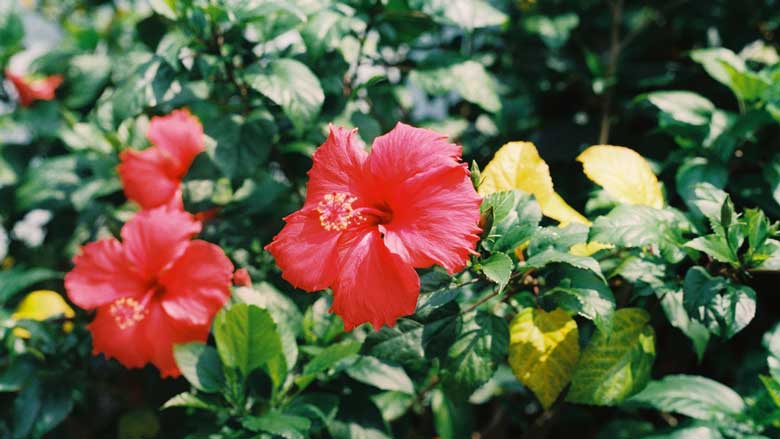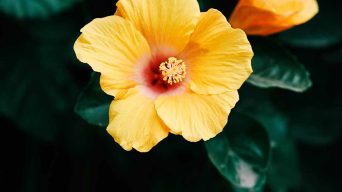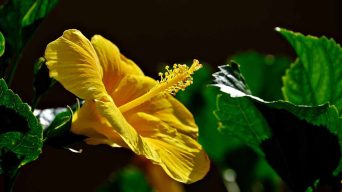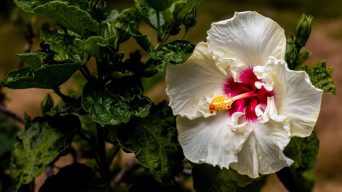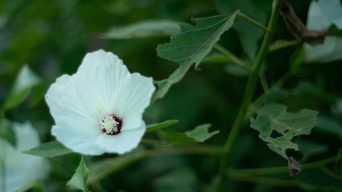Hibiscus leaves may turn yellow due to insufficient water, excessive watering, inadequate light, nutrient deficiencies, temperature stress, transplant shock, pest infestations, root rot, overfertilization, or natural aging. To fix, adjust watering, lighting, and nutrients, manage pests, and ensure suitable temperatures.
The Hibiscus, commonly called rose mallow, hardy Hibiscus, or tropical Hibiscus, is renowned for its striking, large blooms. These flowers exhibit a range of vibrant colors, such as orange, yellow, red, and pink.
Originating from tropical and subtropical regions, the Hibiscus is a favored choice for gardens in warmer climates.
However, a frequent concern among Hibiscus owners is the yellowing of leaves. This discoloration could be a sign of a variety of issues.
Below are 10 potential causes for the yellowing of Hibiscus leaves and corresponding solutions to address the problem.
Hibiscus Leaves Turning Yellow: Causes and Solutions
Hibiscus leaves turning yellow is a common problem that gardeners face.
There are several reasons why this might happen, but fortunately, there are also many other solutions.
Here are 10 possible reasons why your hibiscus leaves might turn yellow and what you can do about it.
1. Insufficient Water
Yellowing leaves on a Hibiscus is often a sign of inadequate water supply.
Native to tropical and subtropical areas, hibiscus requires consistent hydration to flourish.
Dry soil leads to drooping, yellowing, and falling leaves as the plant struggles for moisture.
To maintain a healthy hibiscus, water it regularly, keeping the soil moist but not waterlogged.
Correcting Watering Issues
Regular watering is crucial for hibiscus, and weekly deep watering is beneficial for developing a robust root system resilient to drought.
If your hibiscus shows stress signs, rejuvenate it with a thorough soak.
Submerge it in lukewarm water for 30 minutes in a sink or bucket, then let it drain completely.
2. Excessive Watering
While lacking water can cause Hibiscus leaves to turn yellow, too much water can also be problematic.
Hibiscus are susceptible to root rot, which can occur when the roots are constantly wet.
This will prevent the plant from being able to absorb the nutrients it needs, causing the foliage to turn yellow and eventually drop off.
Also, if the soil does not drain well, the plant could be in water, preventing the roots from getting oxygen.
To prevent overwatering, water your plants only when the soil is dry.
It’s also a good idea to water early in the day so the plants have time to dry out before nightfall.
Adjusting Water Levels for Plant Health
Check the soil first If you think your hibiscus might be overwatered.
If it feels soggy or wet, you are likely watering too often.
Try to allow the soil to dry out completely between waterings, and if possible, try to water Hibiscus plants in the morning so that the leaves have time to dry before nightfall.
If the plant is already showing signs of stress, you can try to revive it by watering less often and allowing the soil to dry out completely between waterings.
3. Inadequate Light Exposure
Hibiscus require ample light to flourish. Insufficient light leads to yellow leaves as the plants struggle to produce food.
This lack of light also results in leggy, weak growth, with smaller, fewer flowers.
To promote robust health and abundant flowering, position your Hibiscus in a spot that receives at least six hours of direct sunlight daily.
More sunlight, if achievable, further enhances growth and flower production.
Optimizing Light Exposure
If your Hibiscus shows signs of stress due to inadequate sunlight, promptly relocate it to a brighter area with full sun exposure.
This shift is crucial for reversing stress symptoms and maintaining plant health.
4. Excessive Light
While Hibiscus need a lot of light to thrive, too much sunlight can also be problematic.
If the leaves are getting direct sun for more than six hours a day, they can start to turn yellow and develop brown patches.
This is because the leaves are sunburned; if the problem is not corrected, the leaves will eventually turn brown and drop off.
To prevent this, place your plant in an area where it will get some partial shade during the day, such as near a window or under a tree.
Protecting From Too Much Sun
If your Hibiscus is getting too much sunlight, the best thing you can do is move it to a shadier location.
If possible, try to protect it from the sun during the day by placing it near a window or under a tree.
If the plants are already showing signs of stress, you can try to protect the leaves from the sun by covering them with a light cloth or placing them in a shady spot.
5. Nutrient Deficiencies
Hibiscus require a range of nutrients for optimal health. A deficiency in any of these can lead to yellow foliage.
The most common deficiency is iron, characterized by yellow leaves with green veins.
Other deficiencies, like magnesium, manganese, and zinc, can also cause yellow leaves.
Enrich the soil with compost or organic fertilizer before planting to prevent these deficiencies. Regular fertilization throughout the growing season is crucial.
Supplementing Essential Nutrients
When signs of nutrient deficiency appear in your Hibiscus, applying a balanced fertilizer is advisable.
Periodic soil testing is beneficial to ensure it has the necessary nutrients.
Additionally, repotting the plant in nutrient-rich soil can effectively address deficiencies.
6. Extreme Temperatures
Hibiscus, a tropical species, thrives in warm environments. When exposed to cold, its foliage may turn yellow and fall off.
These plants can endure temperatures as low as 50°F, but optimal growth requires a warmer setting.
To avoid temperature stress, position your Hibiscus in a spot where temperatures consistently exceed 60°F.
Managing Temperature Stress
If your Hibiscus shows signs of temperature stress, relocating it to an area above 70°F is ideal.
In cases where the plant is already stressed, supplementary heat, such as a heat lamp, might be necessary to revive it.
7. Transplant Shock
Hibiscus are very sensitive to transplanting and can often go into shock when moved to a new location.
This can cause the foliage to turn yellow and drop off.
When transplanting a plant, taking special care is essential not to damage the roots.
It’s common for the roots to be damaged when transplanting, so it’s important to be very careful.
To prevent transplant shock, handle the plant carefully and avoid damaging the roots.
It’s also good to water the plant well after transplanting and keep it in a shady spot until it recovers.
Managing Transplant Stress
If your Hibiscus is experiencing transplant shock, the best thing you can do is water it well and keep it in a shady spot until it recovers.
The plant will likely lose some leaves, but it should eventually recover.
If the roots were damaged during transplanting, you might need to replant it in fresh soil.
This helps prevent the plant from going into shock and allows it to recover more quickly.
8. Pest Infestation
Hibiscus, while beautiful, are prone to pest attacks, leading to yellowing and dropping of leaves.
Common culprits like aphids, mealybugs, whiteflies, and spider mites feed on leaf sap, causing damage and discoloration.
Regular monitoring of your Hibiscus for pest presence is crucial for prevention.
Controlling Pest Infestations
In the event of an infestation, treating the plant with neem oil or insecticidal soap is highly effective.
These solutions eradicate pests without harming the Hibiscus.
However, multiple applications may be necessary for complete pest elimination.
Additionally, gently wiping the leaves with a damp cloth can help physically remove any lingering pests.
9. Root Rot
Root rot, a prevalent issue in Hibiscus, often manifests as yellow leaves that eventually fall off.
This condition typically arises from excessive watering, particularly in potted plants.
As the plant’s roots decay, leaf discoloration and shedding occur.
Water the Hibiscus only when the soil feels dry to prevent root rot.
Additionally, planting in pots with drainage holes is advisable to facilitate the escape of surplus water.
Addressing Root Issues
If root rot does afflict your Hibiscus, promptly remove the plant from its pot and transfer it to fresh, dry soil.
Trimming away any decayed roots is also crucial.
For future prevention, consider repotting in a container equipped with drainage holes, further ensuring proper water management.
10. Overfertilization
Hibiscuses are susceptible to overfertilization; the leaves will turn yellow if fertilized too much.
They need to be fertilized only once a month during the growing season, and if they are fertilized more than that, the leaves will start to turn yellow.
Overfertilization can burn the plant’s roots and cause the leaves to turn yellow and drop off.
To prevent overfertilization, fertilize your plant only once a month during the growing season.
If you notice the leaves turning yellow, stop fertilizing the plant and wait for the leaves to recover.
Addressing Fertilization Issues
If your Hibiscus is suffering from overfertilization, the best thing you can do is stop fertilizing it and wait for the leaves to recover.
You may also need to flush the soil with water to remove any excess fertilizer built up.
After a few weeks, the plant should recover, and the leaves should return to their normal color.
11. Natural Aging Process
The yellowing of leaves is a natural part of their life cycle, indicating they are old and ready to fall off.
This is not a cause for concern as it is a typical process for the plant.
When the old leaves fall, the Hibiscus will generate new ones in their place.
Understanding Natural Leaf Yellowing
No action is required if you notice your plant’s leaves turning yellow naturally.
Allow the old leaves to shed, and soon, new growth will appear.
Should I Remove Yellow Leaves From Hibiscus Plants?
Hibiscus are known for their bright, vibrant flowers. However, sometimes, the leaves turn yellow.
While this may be alarming, there is usually no cause for concern.
Leaves may turn yellow for a few reasons, including stress, lack of nutrients, or disease.
In most cases, the Hibiscus will recover independently for some time.
However, if the leaves remain yellow and appear wilted or unhealthy, removing them from the plant is best.
This will help the Hibiscus to focus its energy on healthy growth and prevent the spread of diseases.
Hibiscus Plant Seasonal Concerns: Yellow Leaves in Winter
One of the most common reasons Hibiscus leaves turn yellow is the plant’s response to shorter days and cooler winter temperatures.
This is normal behavior and nothing to worry about.
The plant will likely go dormant during this time, so there is no need to take any action.
Watch the Hibiscus and provide necessary care, such as water and sunlight.
If the leaves do not return to their normal color by spring, another problem may exist.
But if the leaves are beginning to turn yellow and it is still early in the winter, then there is no cause for concern.
Sudden Changes: Yellow Leaves Overnight
Experiencing your Hibiscus plant’s leaves turning yellow seemingly overnight can be quite alarming. This abrupt discoloration often indicates stress in the plant. Native to tropical weather, Hibiscus thrives in warm, humid environments.
Exposure to extreme temperatures, either too cold or too hot, can shock the plant, leading to yellow leaves.
Stress in Hibiscus isn’t limited to temperature fluctuations. It can also arise from improper watering—either too much or too little—or a sudden shift in light exposure.
If you notice your Hibiscus exhibiting these symptoms, it’s crucial to pinpoint the stressor.
Once identified, taking appropriate measures to mitigate the stress can help restore your plant’s health.
Identifying Diseases: Yellow Leaves with Black Spots
The appearance of yellow leaves with black spots on a Hibiscus typically indicates a fungal disease.
These infections thrive in humid or wet conditions. Immediate action is crucial upon spotting black spots on the leaves.
Start by removing and properly disposing of the affected leaves.
To halt the spread of the infection, treat the Hibiscus with a fungicide continuously for a minimum of two weeks.
Additionally, isolate the hibiscus from other plants as a precautionary measure to prevent cross-contamination.
Signs of Decay: Yellow Leaves with Brown Spots
When Hibiscus leaves exhibit yellowing with brown spots, it often indicates fertilizer burn.
This condition arises when plants receive excessive fertilizer, accumulating nutrients beyond what the roots can absorb.
Consequently, this nutrient overload manifests as yellow leaves with brown spots due to the buildup of excess fertilizer.
To address this issue, cease fertilization and thoroughly flush the soil with water, aiming to expel residual fertilizer.
With these steps, the hibiscus will likely recuperate within a few weeks.
Stress Indicators: Yellow Leaves Falling Off
Yellowing and shedding hibiscus leaves can be attributed to stress, pests, or diseases. Stress typically causes only discoloration.
However, pests or diseases are likely culprits when leaves turn yellow and fall off. Aphids, whiteflies, and mealybugs, notorious for extracting nutrients from leaves, often lead to such damage.
Additionally, diseases like powdery mildew and rust can trigger these symptoms.
To address this, inspect the Hibiscus for pest infestations or disease signs. Once identified, apply the appropriate insecticide or fungicide for treatment.
Leaf Health: Addressing Yellowing and Curling Leaves
If the leaves on your Hibiscus are yellow and curling, they’re likely not getting enough water.
The leaves will turn yellow and curl inward as the plant tries to conserve moisture.
If you think your Hibiscus is not getting enough water, check the soil to see if it is dry.
Water the plant deeply and regularly to prevent the leaves from turning yellow and curling.
You may also need to increase the humidity around the Hibiscus if it grows in a dry environment.
Final Thoughts
Growing Hibiscus offers a fulfilling gardening experience. However, it’s crucial to be mindful of potential issues.
When you observe yellow leaves, promptly identify and address the underlying problem.
Your Hibiscus will flourish with diligent care, gracing your garden with stunning flowers for many years.

